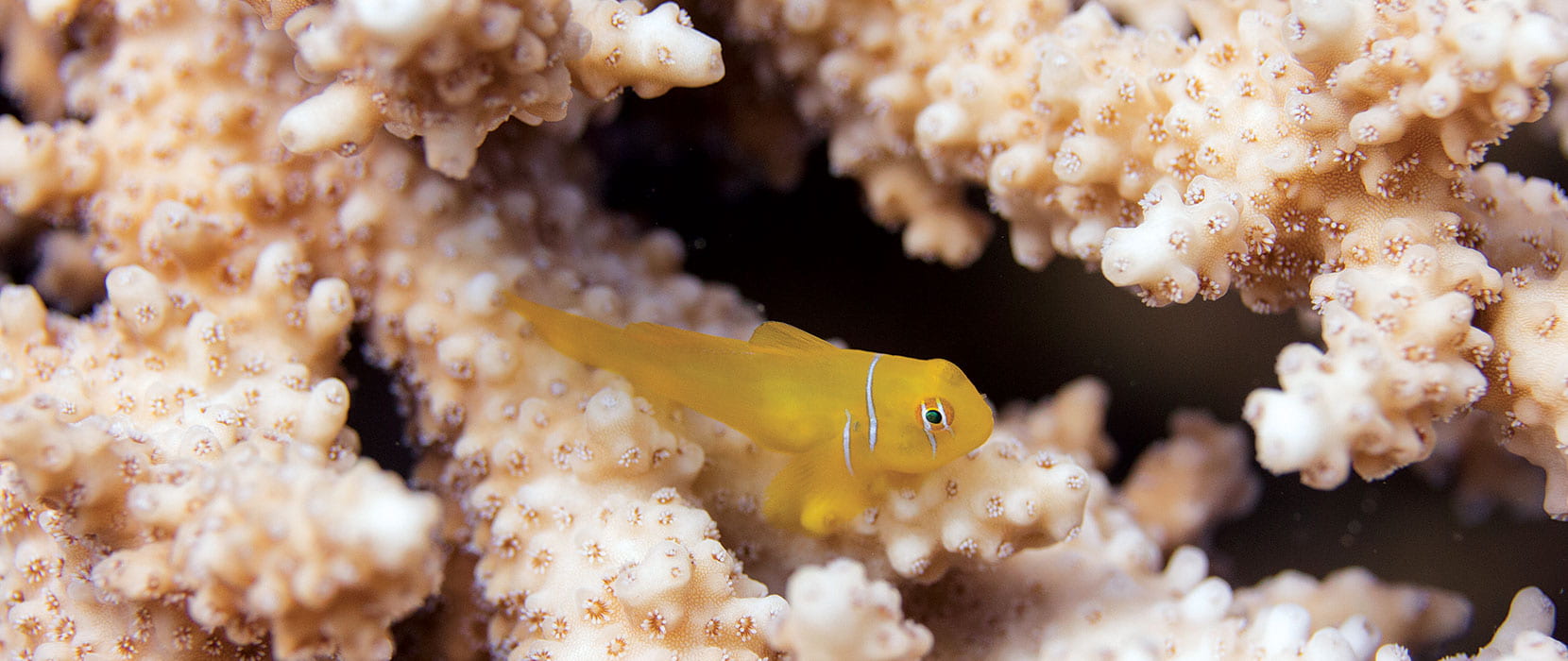They’ve been called the Tim Tams of the reef … but I don’t agree with all that.
Dr Chris Goatley
Postdoctoral Research Fellow, School of Environmental and Rural Science.
While most of us are aware that coral reefs abound with life, many may not realise that most reefs exist in “marine deserts”. Recent work by Dr Chris Goatley, a postdoctoral research fellow at UNE, and colleagues, is helping to reveal how the unlikeliest of creatures may be critically important in helping reefs survive in these seemingly harsh conditions.
The reason that the water around many coral reefs is so clear, is because there are few nutrients in it, and, as such, few microscopic planktonic organisms floating in the water. With such limited availability of food in the water column, reefs have to rely on highly efficient recycling processes to keep the nutrients they have within the reef ecosystem. We unfortunately still know little about how this recycling occurs.
Enter the humble goby (and friends). Dr Goatley and his colleagues are focussing their research on the smallest fishes on the reef (and indeed some of the smallest backboned animals on the planet). Most of these fishes remain smaller than 5cm for their entire lives and weigh almost nothing; 50 of these fish would easily weigh less than a dollar coin. These innocuous fish are generally mottled brown-green, live hidden on the seabed and are practically invisible. As a group, they call these fishes “cryptobenthic reef fishes” or more simply “cryptos”. Cryptos may not be the most exciting fishes to look at (without a microscope that is), but they have a few quirks that make them rather special.
First, there are lots of them. On an average square metre of the Great Barrier Reef there are more than 30 of these little fishes. In fact, they account for about 40% of all fish on a coral reef. Yet, because they are so small and are often hidden within the reef itself, it is almost impossible to see them. To work out how many fish, and what species are present, researchers must resort to using anaesthetics, and plenty of elbow grease. Clove oil is pumped onto small areas of the reef (about the size of a double bed), which knocks the cryptos unconscious. Then the researchers spend almost an hour collecting the anaesthetised fishes with tweezers and zip lock bags. These techniques give the researchers a unique insight into the biodiversity of coral reefs.
“We regularly find that there are 15 or more species of cryptos in every square metre of reef” says Dr Goatley. “But what’s really exciting is that often these are species that we didn’t know existed in that area, or are even new to science.” On a recent trip to Lizard Island Research Station, one of the best studied reef systems in the world, Dr Goatley and his colleagues found at least 5 species which were either not previously known from Australian waters, or species entirely new to science.
The second crypto-quirk is that they live only a very short time. As some of the most abundant fish on the reef, they may only live 8 weeks. This includes 3 weeks spent floating out in the plankton, and around 11 days, after they settle onto a reef, to mature. This leaves some cryptos just three and a half weeks to find a mate and reproduce, then sometimes change sex and reproduce again. Rapid reproduction is vital for these fishes to maintain their populations with such short lifespans. What is fascinating, is that if you keep cryptos in a fish tank, they can live for years. So why do they die so quickly on the reef? The answer is they get eaten by anything that can fit these little fish in their mouths.
“They’ve been called the Tim Tams of the reef,” laughs Dr Goatley, “but I don’t agree with that at all.” The reason for this, he explains, is that cryptos are probably not a treat for other reef organisms, but a staple food. “Without cryptos to eat, the food chain could collapse (ed. unlikely following a Tim Tam shortage). They are an abundant source of protein that larger fishes and even lots of invertebrates, like shrimps, rely on.” This is where the importance of cryptos in recycling reef nutrients starts to become clear.
The main food of cryptos is often detritus or microscopic detritus-feeding crustaceans. Detritus consists of particles of organic reef “waste;” essentially a nutrient-rich “sludge” which could easily be washed off the reef and lost from the ecosystem, taking these nutrients with it. The sheer numbers of cryptos, feeding on detrital material, means that the nutrients are kept in the ecosystem. This nutritious food permits cryptos to grow quickly and reproduce rapidly enough to maintain their populations. Then, when they are eaten (at rates of 50% of the population every week), these nutrients are fed back into coral reef food chains, and the recycling can begin again.
It appears the smallest fish on the reef are among the most important. But there is still much to learn. “We are only just beginning to understand the importance of these fishes. We don’t even have names for some of the most common Australian species,” highlights Dr Goatley. Hopefully these fish will reveal their secrets soon.


